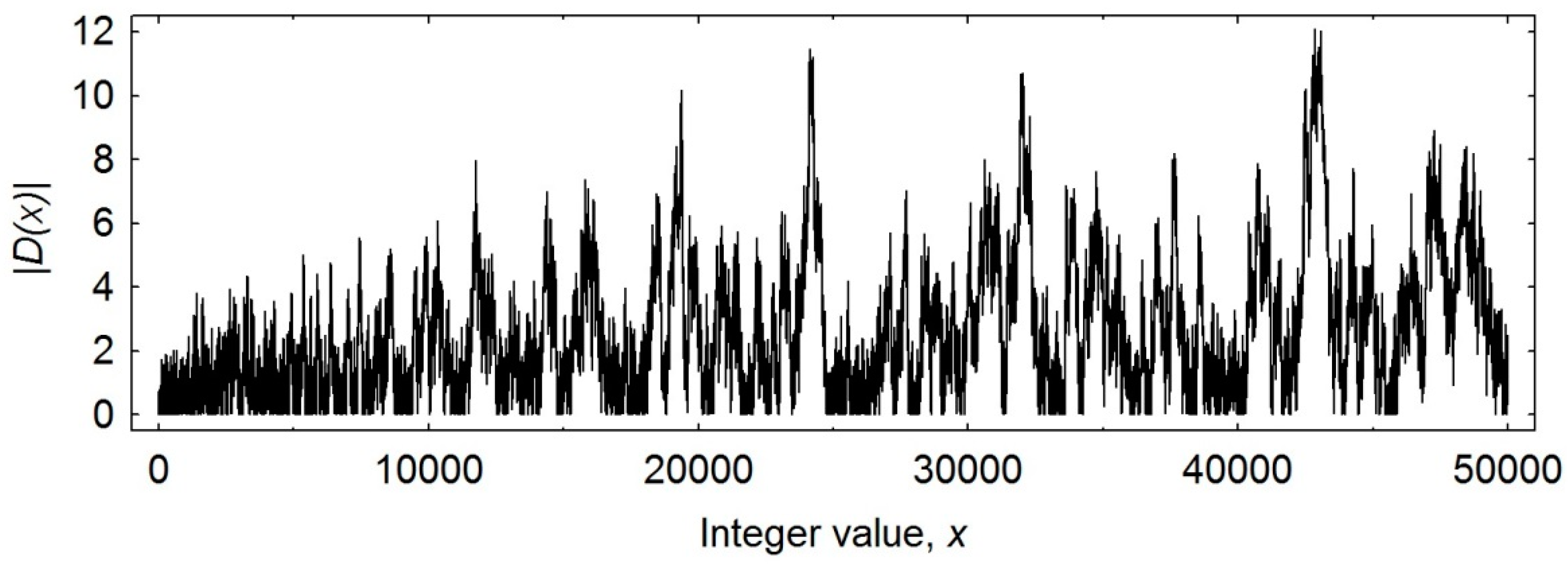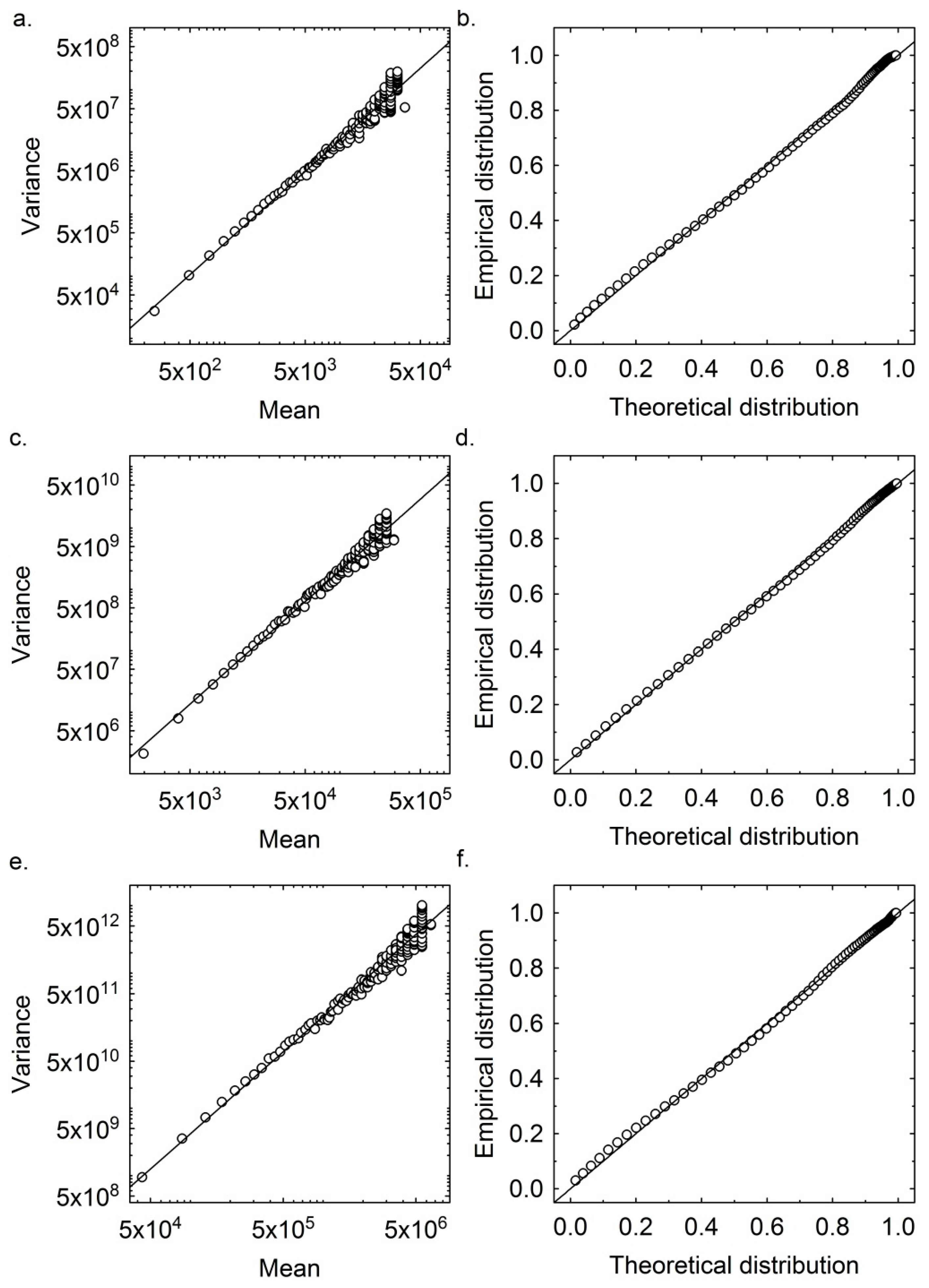A Scale Invariant Distribution of the Prime Numbers
Abstract
:1. Introduction
2. Experimental Section
3. Results and Discussion
3.1. The Variance Function of the Prime Number Deviations



3.2. Prime Number Deviations as a Self-Similar Process
3.3. 1/f Noise from the Prime Number Deviations
3.4. Prime Number Deviations Described by a Tweedie Exponential Dispersion Model
3.5. The Tweedie Convergence Theorem
3.6. The Theoretical Behavior of the Prime Number Deviations
3.7. Other Examples of Variance to Mean Power Laws and 1/f Noise
4. Conclusions
Acknowledgments
Author Contributions
Conflicts of Interest
References
- Kotnik, T. The prime-counting function and its analytic approximations π(x) and its approximations. Adv. Comput. Math. 2008, 29, 55–70. [Google Scholar] [CrossRef]
- Legendre, A.M. Essai sur la Théorie des Nombres, 2nd ed.; Courcier: Paris, France, 1808; p. 394. (In French) [Google Scholar]
- Gauss, C.F. Werke Band 2, 1st ed.; Königliche Gesellschaft der Wissenschaften zu Göttingen: Göttingen, Germany, 1863; Volume 2, pp. 444–447. (In German) [Google Scholar]
- Hadamard, J. Sur la distribution des zéros de la fonction et ses conséquences arithmétiques. Bull. Soc. Math. Fr. 1896, 24, 199–220. (In German) [Google Scholar]
- De la Vallée Poussin, C.J. Recherches analytiques la théorie des nombres premiers. Ann. Soc. Sci. Brux. 1896, 20, 183–256. (In German) [Google Scholar]
- Riemann, G.F.B. Über die anzahl der primzahlen unter einer gegebenen grösse. Mon. Berl. Akad. 1859, 2, 671–680. (In German) [Google Scholar]
- Borwein, J.M.; Bradley, D.M.; Crandall, R.E. Computational strategies for the Riemann zeta function. J. Comp. Appl. Math. 2000, 121, 247–296. [Google Scholar] [CrossRef]
- Mertens, F. Über eine zahlentheoretische funktion. Akad. Wiss. Math. Nat. Kleine Sitz. 1897, 106, 761–830. (In German) [Google Scholar]
- Titchmarsh, E.C. The Theory of the Riemann Zeta-Function, 2nd ed.; The Clarendon Oxford University Press: New York, NY, USA, 1986. [Google Scholar]
- Gamba, Z.; Hernando, A.; Romanelli, L. Are prime numbers regularly ordered? Phys. Lett. A 1990, 145, 106–108. [Google Scholar] [CrossRef]
- Wolf, M. 1/ƒ noise in the distribution of prime numbers. Phys. A 1997, 241, 493–499. [Google Scholar] [CrossRef]
- Kriecherbauer, T.; Marklof, J.; Soshnikov, A. Random matrices and quantum chaos. Proc. Natl. Acad. Sci. USA 2001, 98, 10531–10532. [Google Scholar] [CrossRef] [PubMed]
- Jørgensen, B. The Theory of Dispersion Models; Chapman & Hall: London, UK, 1997. [Google Scholar]
- Jørgensen, B.; Martínez, J.R.; Tsao, M. Asymptotic behaviour of the variance function. Scand. J. Stat. 1994, 213, 223–243. [Google Scholar]
- Kendal, W.S. Self-organized criticality attributed to a central limit-like convergence effect. Phys. A 2015, 412, 141–150. [Google Scholar] [CrossRef]
- Riesel, H.; Göhl, G. Some calculations related to Riemann’s prime number formula. Math. Comput. 1970, 24, 969–983. [Google Scholar] [CrossRef]
- Leland, W.E.; Taqqu, M.S.; Willinger, W.; Wilson, D.V. On the self-similar nature of ethernet traffic. IEE/ACM Trans. Netw. 1994, 2, 1–15. [Google Scholar] [CrossRef]
- Tsybakov, B.; Georganas, N.D. On self-similar traffic in atm queues: Definitions, overflow probability bound, and cell delay distribution. IEEE/ACM Trans. Netw. 1997, 5, 397–409. [Google Scholar] [CrossRef]
- McQuarrie, D.A. Statistical Mechanics; Harper & Row: New York, NY, USA, 1976; pp. 553–561. [Google Scholar]
- Tweedie, M.C.K. An index which distinguishes between some important exponential families. In Statistics: Applications and New Directions, Proceedings of the Indian Statistical Institute Golden Jubilee International Conference, Calcutta, India, 27 September–1 October 1982; Ghosh, J.K., Roy, J., Eds.; Indian Statistical Institute: Calcutta, India, 1984; pp. 579–604. [Google Scholar]
- Taylor, L.R. Aggregation, variance and the mean. Nature 1961, 189, 732–735. [Google Scholar] [CrossRef]
- Anderson, R.M.; May, R.M. Epidemiological parameters of HIV transmission. Nature 1988, 333, 514–519. [Google Scholar] [CrossRef] [PubMed]
- Philippe, P. The scale-invariant spatial clustering of leukemia in San Francisco. J. Theor. Biol. 1999, 199, 371–381. [Google Scholar] [CrossRef] [PubMed]
- Kendal, W.S.; Frost, P. Experimental metastasis: A novel application of the variance-to-mean power function. J. Natl. Cancer Inst. 1987, 79, 1113–1115. [Google Scholar] [PubMed]
- Rhodes, C.J.; Anderson, R.M. A scaling analysis of measles epidemics in a small population. Philos. Trans. R. Soc. Lond. B Biol. Sci. 1996, 351, 1679–1688. [Google Scholar] [CrossRef] [PubMed]
- Kendal, W.S. A stochastic model for the self-similar heterogeneity of regional organ blood flow. Proc. Natl. Acad. Sci. USA 2001, 98, 837–841. [Google Scholar] [CrossRef] [PubMed]
- Kendal, W.S. An exponential dispersion model for the distribution of human single nucleotide polymorphisms. Mol. Biol. Evol. 2003, 20, 579–590. [Google Scholar] [CrossRef] [PubMed]
- Kendal, W.S. A scale invariant clustering of genes on human chromosome 7. BMC Evol. Biol. 2004, 4, 3. [Google Scholar] [CrossRef] [PubMed] [Green Version]
- Lowen, S.B.; Teich, M.C. The periodogram and Allan variance reveal fractal exponents greater than unitiy in auditory-nerve spike trains. J. Acoust. Soc. Am. 1996, 99, 3585–3591. [Google Scholar] [CrossRef] [PubMed]
- Sato, A.H.; Nishimura, M.; Holyst, J.A. Fluctuation scaling of quotation activities in the foreign exchange market. Phys. A 2010, 389, 2793–2804. [Google Scholar] [CrossRef] [Green Version]
- Eisler, Z.; Bartos, I.; Kertesz, J. Fluctuation scaling in complex systems: Taylor’s law and beyond. Adv. Phys. 2008, 57, 89–142. [Google Scholar] [CrossRef]
- Fronczak, A.; Fronczak, P. Origins of Taylor’s power law for fluctuation scaling in complex systems. Phys. Rev. E 2010, 81, 066112. [Google Scholar] [CrossRef]
- Jørgensen, B.; Vinogradov, V. Convergence to tweedie models and related topics. In Advances on Theoretical and Methodological Aspects of Probability and Statistics; Balakrishnan, N., Ed.; Taylor & Francis: New York, NY, USA, 2002; pp. 473–489. [Google Scholar]
- Vinogradov, V.; Jørgensen, B.; Wentzell, B.D. From extreme stable laws to Tweedie exponential dispersion models. In Stochastic Models, Proceedings of the International Conference on Stochastic Models, Ottawa, ON, Canada, 10–13 June 1998; Dawson, D.A., Gorostiva, L., Ivanoff, G., Eds.; American Mathematical Society: Providence, RI, USA, 1999; pp. 435–443. [Google Scholar]
- Kendal, W.S.; Jørgensen, B. Tweedie convergence: A mathematical basis for Taylor’s power law, 1/f noise and multifractality. Phys. Rev. E 2011, 84, 066120. [Google Scholar] [CrossRef]
- Kendal, W.S.; Jørgensen, B. Taylor’s power law and fluctuation scaling explained by a central-limit-like convergence. Phys. Rev. E 2011, 83, 066115. [Google Scholar] [CrossRef]
- Kendal, W.S. Fluctuation scaling and 1/f noise: Shared origins from the Tweedie family of statistical distributions. J. Basic Appl. Phys. 2013, 2, 40–49. [Google Scholar] [CrossRef]
- Kendal, W.S. Multifractality attributed to dual central limit-like convergence effects. Phys. A 2014, 401, 22–33. [Google Scholar] [CrossRef]
- Dutta, P.; Horn, P.M. Low-frequency fluctuations in solids: 1/f noise. Rev. Mod. Phys. 1981, 53, 497–516. [Google Scholar] [CrossRef]
- Musha, T. 1/f Fluctuations in Biological Systems. In Proceedings of the Sixth International Conference on Noise in Physical Systems, Washington, DC, USA, 6–10 April 1981; pp. 143–146.
- Bak, P.; Tang, C.; Wiesenfeld, K. Self-organized criticality: An explanation of the 1/f noise. Phys. Rev. Lett. 1987, 59, 381–384. [Google Scholar] [CrossRef] [PubMed]
- Kendal, W.S. Scale invariant correlations between genes and SNPs on human chromosome 1 reveal potential evolutionary mechanisms. J. Theor. Biol. 2007, 245, 329–340. [Google Scholar] [CrossRef] [PubMed]
- Cattani, C. Fractal patterns in prime numbers distribution. Lect. Notes Comput. Sci. 2010, 6017, 164–176. [Google Scholar]
- Van Zyl, B.P.; Hutchinson, D.A.W. Riemann zeros, prime numbers, and fractal potentials. Phys. Rev. E 2003, 67, 066211. [Google Scholar] [CrossRef]
- Holdom, B. Scale-invariant correlations and the distribution of prime numbers. J. Phys. A Math. Theor. 2009, 42, 345102. [Google Scholar] [CrossRef]
- Shlesinger, M.F. On the Riemann hypothesis: A fractal random walk approach. Phys. A 1986, 138, 310–319. [Google Scholar] [CrossRef]
- Stanley, H.E.; Meakin, P. Multifractal phenomena in physics and chemistry. Nature 1988, 335, 405–409. [Google Scholar] [CrossRef]
- Erdös, P.; Kac, M. The Gaussian law of errors in the theory of additive number theoretic functions. Am. J. Math. 1940, 62, 738–742. [Google Scholar] [CrossRef]
© 2015 by the authors; licensee MDPI, Basel, Switzerland. This article is an open access article distributed under the terms and conditions of the Creative Commons Attribution license (http://creativecommons.org/licenses/by/4.0/).
Share and Cite
Kendal, W.S.; Jørgensen, B. A Scale Invariant Distribution of the Prime Numbers. Computation 2015, 3, 528-540. https://doi.org/10.3390/computation3040528
Kendal WS, Jørgensen B. A Scale Invariant Distribution of the Prime Numbers. Computation. 2015; 3(4):528-540. https://doi.org/10.3390/computation3040528
Chicago/Turabian StyleKendal, Wayne S., and Bent Jørgensen. 2015. "A Scale Invariant Distribution of the Prime Numbers" Computation 3, no. 4: 528-540. https://doi.org/10.3390/computation3040528




